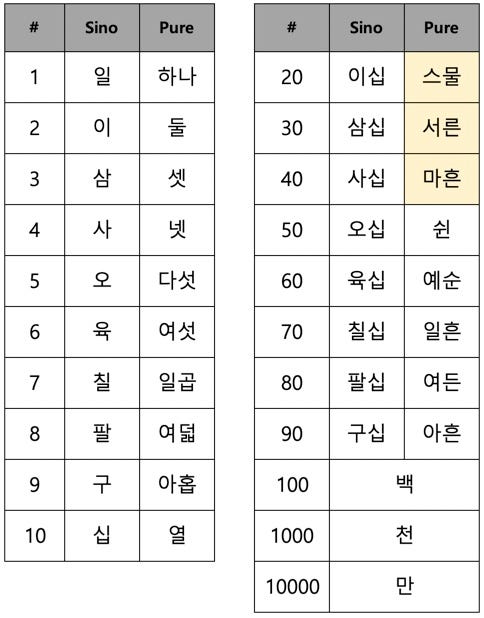Numbers and Counters
In this lesson we’re going to learn about the two Korean number systems, as well as Korean counters and how you use them. The main counters we will learn are 개, 명, 분, 마리, and 잔. We will also look at some other counters.
Korean number system
──────────────────
Korean uses two different number systems in their everyday language. These are the sino-Korean numbers (which originated from Chinese numbers) and native Korean numbers. When the different number systems are used varies and this is something you just have to learn when you see it.
The sino-Korean numbers are used for:
- Years
- Days
- Minutes
- Seconds
The native Korean numbers are used for:
- Months
- Age
- Amount of people, animals, objects
What are counters?
──────────────────
Korean, like many East Asian languages, uses counters. Counters are words that come after a number. They indicate a property of the thing you are counting. For example, the counter 시 is used to indicate the hour of the time.
English has a similar concept. For uncountable objects like liquids, you must add “glass(es)” in front of the liquid to give it a number. Ex: 1 glass of water, 2 glasses of wine, etc.
There are specific counters for each noun in Korean. Make sure to use the correct one!
Counter rules
──────────────────
Counters use both the Native and Sino Korean number systems.
For the ones listed in this lesson, use the Native Korean number system.
Irregulars (applies to all counters)
하나 > 한
- 하나 개 > 한 개
둘 > 두
- 둘 개 > 두 개
셋 > 세
- 셋 개 > 세 개
넷 > 네
- 넷 개 > 네 개
스물 > 스무
- 스물 개 > 스무 개
개
Used for general objects
If there isn’t a specific/common counter for an object, assume it’s 개
If there is a specific/common counterᅧ for an object and you use 개, you run the risk
of seeming rude or uneducated.
Common objects
손 (hand)
> 손 두 개 있습니다.
> We have two hands.
전화기, 핸드폰, 등등 (phone, cell phone, etc.)
> 전화기 한 개 샀어요.
> I bought one phone.
거울 (mirror)
> 거울 다섯
개 > Five mirrors
명
Used for humans
DO NOT USE 개! You will be seen as extremely rude.
Usage
오늘 파티에 몇 명이 와?
How many people are coming to the party today?
오늘 열 명이 와.
Ten people are coming today.
분
Used for humans (formal)
Used for minutes (time)
Usage
내일 회식에 다섯 분이 오실 겁니다.
Five people are going to come to the outing tomorrow.
몇 분을 셌어?
How many people did you count?
*Note: It does not matter whether or not the sentence is formal. If the person/people you are referring to deserve respect, you use 분.
여기서 대전까지 10분 걸려.
It takes 10 minutes to go from here to Daejeon.
마리
Used for animals (not humans though!)
Usage
개 여러 마리가 뛰어왔어요!
Many dogs came running over!
돼지 스무 마리가 꿀꿀 하며 밥을 먹었습니다.
Twenty pigs oinked as they ate their food.
잔
Used for cups/glasses
Usage
물 한 잔 따라줘.
Pour me a glass of water.
와인 두 잔 주세요.
Please give us two glasses of wine.
Other counters
These do not encompass all Korean counters! There are hundreds of counters in Korean and some are even uncommon. The ones listed below are a few common counters that you should memorize.
Native Korean number system
- 대 (vehicles and machinery)
- 권 (books)
- 송이 (flowers)
- 장 (paper-like objects)
- 자루 (long-handled objects, usually pencils)
- 시 (hour)
- 달 (month)
- 통 (containers)
Sino Korean number system
- 일 (day)
- 년 (year)
- 월 (month of the year)
- 학년 (school grade [ex: 1st grade, 2nd grade, etc.])
- 원 (Korean Won ₩)

Comments
Post a Comment